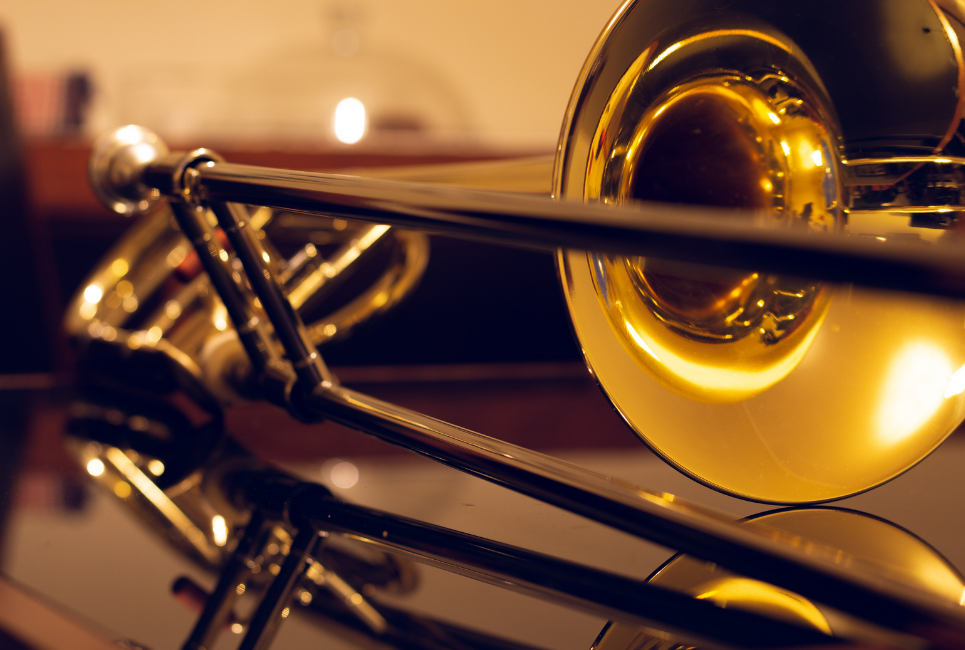- How to Find the Best Alto Trombone - May 31, 2022
- How to Find the Best Bass Trumpets - April 23, 2022
- Best Yamaha Saxophones Brand Guide - April 21, 2022
The trombone is visually and sonically distinctive with its long slide and distinctive glissandos. But the instrument most people think of when they hear the word “trombone” is just the most prominent member of a whole family of brass horns with a history stretching back over 600 years! Today you can find Renaissance replications alongside instruments using cutting-edge materials.
Today trombones are found on stages, in recording studios, playing in Orchestra pits, or marching in parades and shows. Trombones can blast a war cry or play a soft eulogy: they can go from reverent to raunchy in a heartbeat. The trombone can evoke a broad palette of emotions and play across a wide range. If you’re curious about the many things you can do with trombones, you’ve come to the right place. Read on and learn more!
History of the Trombone
Since prehistoric times we have known that we can make loud noises by blowing into a horn. The shofar, the ram’s horn still used by observant Jews on important religious occasions, may be the most ancient musical instrument still in regular usage. With the advent of the bronze age, musicians began using brass tubes with flared bells.
Today you’re most likely to hear a trombone in a jazz club or marching band. During the Renaissance, trombonists were most frequently found accompanying church choirs. Long slide horns mourned during requiems and blasted rallying cries during hosannas. But while those slide horns looked a great deal like a modern trombone, there were some crucial differences.
The Sackbut: The First Trombone
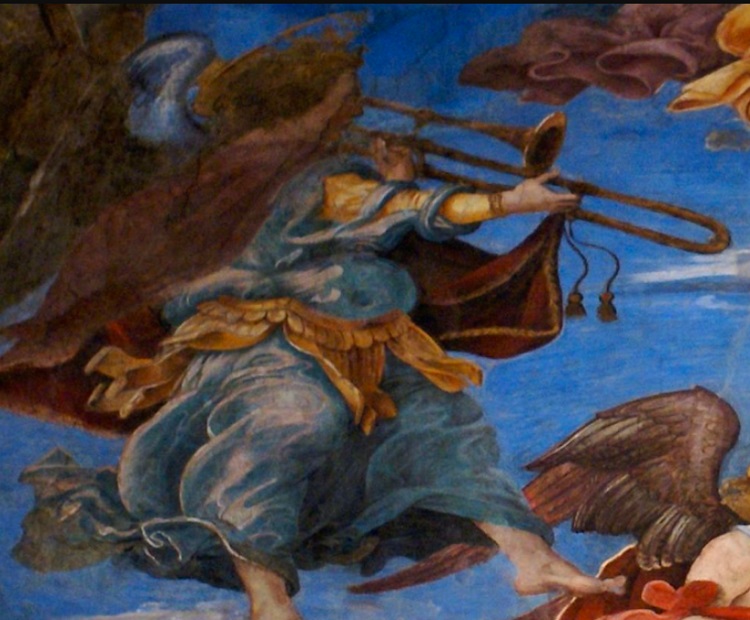
The original brass instruments were long cylindrical tubes with flared bells and a mouthpiece. A musician could play a harmonic series using breath and lip control with these horns. But since they could only play notes within that series, horn players needed a different instrument for each key, which was inconvenient and expensive.
In the 15th century, an inventor added a slide to the horn. A player could extend or shorten the horn’s length with the slide, changing the harmonic series.
This gave horn players more flexibility and saved them from carrying multiple horns to a performance. (If you think hauling your instrument on an Uber ride is challenging, imagine taking a half-dozen horns in an ox cart).
By the 16th century, these slide horns could be found throughout Europe. These slide horns were called trombones in Italian and Pousanes in German. The French called them sacher-bouters (push-pulls). So in England, these new instruments were called “Sackbuts.” (Scotland referred to them by the more dignified draucht trumpets, or “drawn trumpets”).
Like modern trombones, these early instruments came in sizes ranging from alto to double-bass (what we call today “contrabass”). As with modern trombones, the tenor sackbut proved most popular and versatile.
Sackbut vs Modern Trombone
These sackbuts lacked many conveniences we take for granted on modern trombones. The slides lacked the chrome “stockings” we find on modern trombones, and the slide braces were square rather than round like today. This made sackbuts less comfortable and more difficult to play than modern trombones.
While the sackbut looked like the modern trombone, its bore was considerably narrow and the bell less flared. Sackbuts were also built from thick brass than that used in modern trombones. This gave sackbuts a more mellow sound and kept them from overwhelming the other instruments in ensembles.
But perhaps the greatest difference between the sackbut and the contemporary trombone was the stay (brace) holding the bell. Today’s trombone bells are soldered firmly in place by a soldered visit.
The sackbut’s bell was loosely affixed and extended to the slide’s fourth position. (On modern trombones, the bell is at the third). This gave the sackbut an extra resonance that made the sound richer.
By the early 18th century, sackbuts were largely out of fashion everywhere but Germany. Handel hired German horn players when Handel used sackbuts in operas like Saul and Samson.
The Sackbut Today
Since the 1960s, musicians and audiences have grown increasingly interested in performances on period instruments. Sackbuts have benefitted from that revival, and today sackbuts can be found in many period music ensembles. A few manufacturers make reproduction sackbuts with modern touches like chrome stockings and water keys.
The Baroque Trumpet Shop offers two different tenor sackbuts by Swiss instrument maker Adolf Egger. One is a replica of a sackbut built by Sebastian Hainlein of Nuremberg in 1632, and the other replicates a 1579 sackbut made by Anton Schnitzer, the Elder.
Depending on the options you choose, an Egger sackbut will set you back between $4,500 and $9,000. But for that price, you’ll have an instrument that would do any Renaissance sackbutist proud.
The English Cornett and Sackbut Ensemble performed Giovanni Gabrieli’s 1597 “Beata es Virgo” on period instruments.
The Birth of the Modern Trombone
By the mid-18th century, sackbuts were being made with wider bell flares. In place of the flat, removable stays, these new instruments used tubular braces.
The bore was wider, giving them a louder and more penetrating sound suited to the growing fondness for opera music. And because many of these operas were in Italian, these new sackbuts were called by their Italian name, “trombone.”
As the instruments changed, so too did the music. The original tenor sackbut was generally tuned in A, with A between 460 – 480Hz. 19th-century choirmasters and composers tuned A closer to the modern-day A=440hz.
A tenor trombone in the first position playing at 466hz would have been playing A in a Renaissance choir. With A=440hz, that same note would be a B♭.
The 19th century also saw the advent of water keys. Earlier players had to empty their instruments by turning them upside down and shaking. The spit key made it easier to keep corrosive dampness out of your instrument’s tubing. Trombone makers also began adding “stockings” to their slides. The first few inches of your slide are a tiny bit thicker than the rest.
This allows your trombone to move more quickly through difficult packages. And they saw the introduction of a new technology that transformed many brass instruments.
Valve Trombones
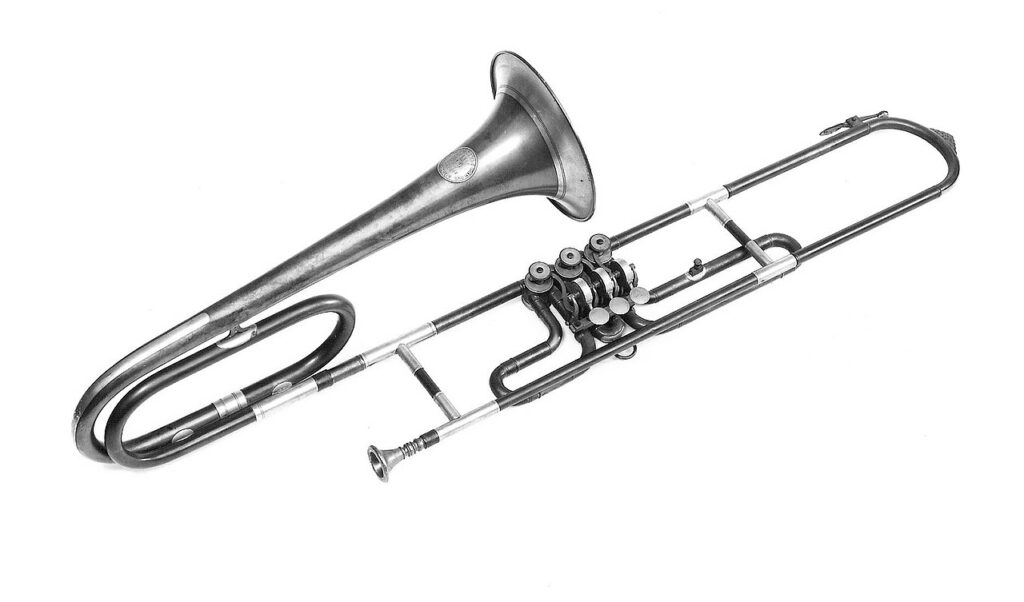
In the early 19th-century, instrument makers developed a new way to change tubing length. These new horns connected lengths of pipe through tightly machined valves. Using the valves, a player could change the tube length and pitch.
Slide trumpet players especially welcomed this. The smaller the instrument, the smaller the space between the positions, and the harder it is to get the exact pitch. But trombone players welcomed these innovations too. By the second quarter of the 19th century, many trombonists traded valve instruments in their slides.
These new instruments were more convenient and compact than slides and required less room. Valve trombones became popular in military bands and pit orchestras. But the same new machining techniques that made valves possible also made it easier to produce more comfortable, accurate, and playable slide trombones.
Today, valve trombones remain popular in Latin America, India, Portugal, and Eastern Europe. Jazz musicians like Bob Brookmeyer and Juan Tizol of the Duke Ellington Orchestra made beautiful music with valve trombones. And valve trombones are a staple of much traditional Central and South American music. However, they prefer their valve trombones in C rather than B♭ tuning.
Still, many musicians and composers overwhelmingly favor slide trombones. However, many of those slide trombones have valves that help extend their range.
Valve Trombone vs Modern Trombone
Like a tenor slide trombone, a valve trombone has 9 feet of tubing, but instead of a slide, players change the pitch by using valves to open and close tubing lengths. Many conductors and arrangers believe valve trombones have inferior tone because the valves make the instrument less free blowing.
But, valve trombones can play fast passages more quickly than a trombone. Moving your fingers rapidly on valves is easier than maneuvering a slide. They also require less space to play.
And a trumpet player will find the fingerings on a valve trombone are identical to a trumpet, with the notes playing an octave lower. (One issue that might arise is that while music for the B♭ trumpet is transposed up a step, music for trombones is not transposed. A “C” on the trombone’s sheet music would be fingered 1-3, like a “D” on trumpet sheet music).
The extra valves and tubing give the valve trombone a mellower timbre like a French horn. Valve trombones are also less suited for the glissandos so often associated with slide trombones. But while they are sometimes seen in jazz ensembles, valve trombones are generally not as popular in most Western orchestras as slide trombones.
For under $600, the Wessex PB901 valve trombone will give trumpeters the ability to play trombone parts without mastering slide positions. While it lacks some of the bells and whistles you might find on more expensive valve trombones, the PB901 will serve you faithfully as a second instrument and even for occasional stage performance.
Valve Trombones and Technology
The King 3B Valve Trombone (available on Amazon) is well-reviewed by valve trombone players. King is one of the most highly regarded brass instruments. You should have little difficulty mastering the valve trombone if you play trumpet, tuba, or euphonium.
Even slide trombones can take advantage of valve technology. Valves that seal or open extra lengths of tubing can change the fundamental pitch on many trombones.
Many professional B♭ tenor trombones have an “F attachment” that can provide an extra five notes on the bottom at the push of a valve. And there is one valve trombone we find in many orchestras, thanks to a very prolific tuba-hating composer.
The Cimbasso: Giussepe Verdi’s Favorite Trombone
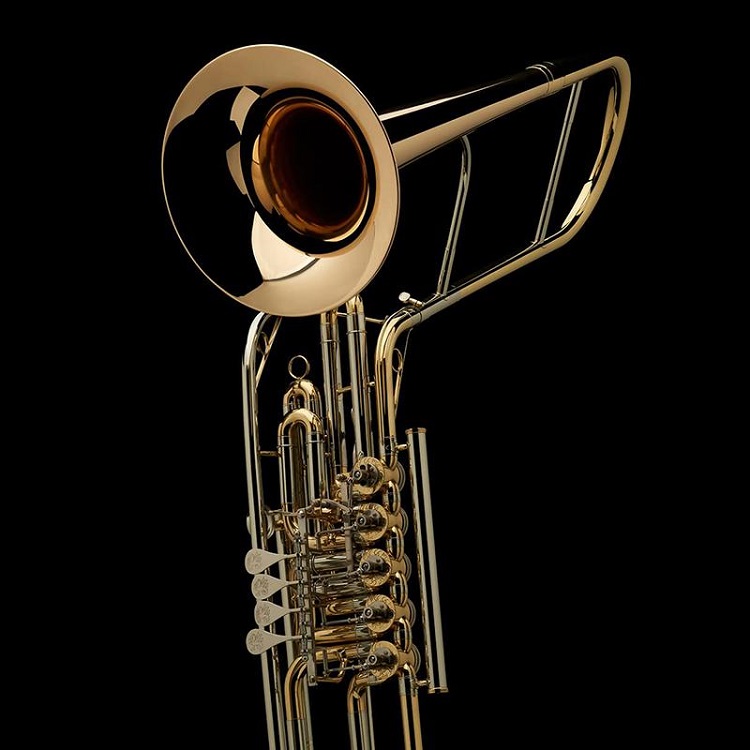
In a letter regarding the staging of an 1878 performance of Aida at the La Scala, Verdi wrote:
I wish to insist again on a fourth trombone. I would prefer a trombone basso which is one of the same family as the others. If this turns out to be too much trouble and is too difficult to play, then get again one of those ordinary ophicleides that go down to the low B.
In fact, use anything you like, but not that devil of a tuba which does not blend with the others!
Before the tuba, composers struggled to fill out the lowest end. While a few contrabass sackbuts and trombones were made, their great length made them unwieldy.
One exception is an instrument built for Giuseppi Verdi as a replacement for what he called “that devil of a tuba which does not blend with the others!” Verdi loathed the tuba’s timbre and felt its conical bore blended poorly with the more slender cylindrical bore trombones. His solution, the valved trombone basso or cimbasso, is known as the trombone basso, Verdi.
The cimbasso has a clearer and more penetrating tone than a tuba. The valves make it more suited for fast passages than the contrabass slide trombone. Because its bell is curved toward the conductor and audience, its sound projects forward.
Construction and Modern Use
The cimbasso was typically made in the key of F or BB♭ and had the same range as an F or BB♭ tuba. But where the tuba’s bell points skyward, the cimbasso’s bell was curved toward the conductor and audience.
The narrower bore and conical tubing give the cimbasso a more penetrating and clear tone. After Verdi’s death, the cimbasso fell out of use, and most orchestras played the cimbasso parts on Verdi’s despised tuba.
Today many audiences prefer period-correct orchestration. Many orchestras use cimbasso when staging Verdi, Puccini, or other Italian composers of the period. Cimbassos have also become increasingly popular with film score composers due to their tone and capabilities.
Cimbassos are expensive, and their repertoire is still limited. But suppose you’re the only cimbasso player in town. In that case, you have a guaranteed gig when your local opera company stages La Traviata.
Modern Cimbassos
Modern cimbasso’s are typically made in F and have the same range as an F tuba. The F cimbasso can play anything in the repertoire and has better intonation than the BB♭ models.
While tubists most often play the cimbasso as a second instrument today, a trombonist might have an easier time mastering the breathing required for proper cimbasso playing.
The cimbasso is also notoriously mouthpiece-sensitive. Many tubists have found they can only make their cimbasso sound right with smaller trombone mouthpieces.
Wessex Tubas designs instruments in the UK, then outsources manufacturing to China. Their Cimbasso in F has received many excellent reviews for its sound and playability.
At over $6,500, the Wessex cimbasso is not cheap – at least not until you compare the Wessex cimbasso to similar cimbasso’s, costing two or three times as much! The Wessex Cimbasso in F ranges from F1 to F4, like an F tuba.
Bonus Historical Trombone: Buccin
What could be cooler than a trombone with a dragon’s head? From 1810-1845 French military bands frequently marched with buccins à têtes des serpents playing the trombone parts. The buccin was nothing if not eye-catching. (For added effect, many buccins had thin metal “tongues” that would flap in time with the music and painted scales and eyes).
Douglas Yeo of the Boston Symphony Orchestra, who plays the buccin and other period trombones, describes the buccin’s sound as a cross between a trombone and a French horn. The imposing-looking buccin has a sweet, mellow sound that belies its fearsome looks at low volumes. Play it louder, and the buccin can produce a roar that would intimidate Smaug.
While many instrument makers replicate historical instruments, nobody currently produces modern buccins. When Yeo wanted to play the buccin part of Hector Berlioz’s 1824 Messe solennelle, he had to commission a maker to build a slide for a restored vintage buccin bell.
The problem is demand: outside the Berlioz Messe, there are no compositions explicitly written for buccin, as the buccin generally covered trombone roles in marches. Another problem is that playing the buccin can be challenging. Not only does the dragon head bell interfere with pitch and tone, but its placement over the shoulder rather than at the usual third position also makes it difficult to place your slide correctly.
Trombone Sizes
Trombones come in many different sizes. Here’s a video introducing the various trombones as they join together in a rendition of the Cuban jazz classic “El Manisero [The Peanut Vendor].”
Tenor Trombone
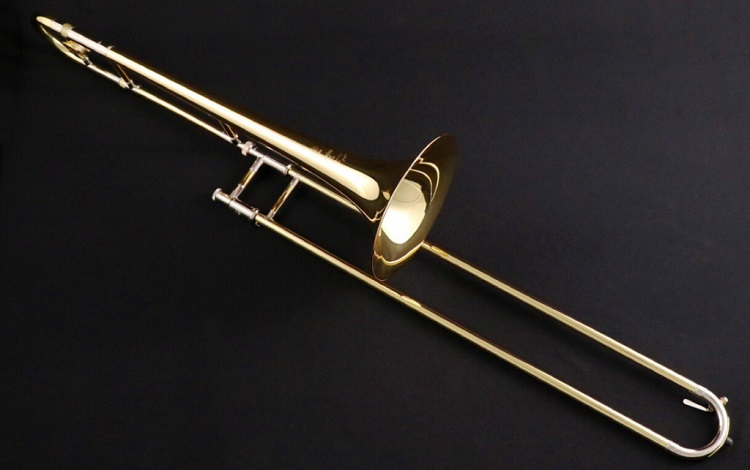
As Goldilocks might say, was she a musician, the tenor slide trombone is just right. The tenor trombone is large enough to give a player some margin for position error, unlike the more difficult smaller trombones. But it is not so large that it becomes an ungainly beast like the contrabass trombone.
Most players can move the slide into all seven positions but are long enough to be forgiving of placement. (The smaller the trombone, the lower the margin for error. It is very challenging to play the smallest slide trombones in tune).
The tenor trombone has a fundamental pitch of B♭ and a range between E2 and D5. Experienced players can extend the lower range with pedal notes and hit higher notes using breath and lip control.
The tenor trombone has 9 feet (2.7m) of tubing, and the fully extended slide adds another 3.5 ft (1.1m) of length. This trombone typically has a fundamental pitch of B♭ and a range between E2 and D5. (Experienced players can extend the lower range with pedal notes and hit higher notes with breath and embouchure control).
Trombones with an F attachment have another 3 feet (0.9m) tubing, which can be sealed or accessed with a valve. This allows the trombone to go down to a C1, the lowest C on the piano.
Modern Tenor Trombones
Modern tenor trombones generally have a bore width ranging between 0.48 and 0.547 inches (12.2-13.9 mm). Narrower “small bore” trombones have a brighter sound. Jazz musicians typically favor them, while wider “large bore” trombones are popular in orchestral settings.
The bell size on a trombone usually ranges from 6.5 to 8.5 inches (165-215mm).
The tenor trombone’s wide range and versatility drove the other trombone sizes into obscurity. Audiences became accustomed to hearing bass and alto trombone lines played on a tenor.
Today many trombones obscure for generations are once again found in concert halls. But that has done nothing to dampen our enthusiasm for the sound of the instrument we’ve come to call simply “the trombone.”
In my list of the best Yamaha trombones, I suggested several excellent Yamaha trombones for players ranging from student to professional level. Yamaha is renowned for its reliably superior craftsmanship, and many professional trombonists play Yamaha instruments. The YSL-891Z is a serious professional instrument well suited for jazz or orchestral work. If you are a beginning trombonist, Yamaha’s YSL-354 will help you master the skills you will need for all sizes of a trombone.
There are many other fine trombone makers out there. Other highly regarded trombone makers include Conn & Selmer and Bach.
Bass Trombone

Today’s bass trombone is no bigger than a tenor trombone and is also pitched in B♭; it has additional features to produce a stronger low end.
While many tenor trombones have an F attachment, modern bass trombones have another valve that puts the trombone in G♭. When both valves are engaged, the trombone drops to an E♭ tuning with a bottom pedal note of B♭0 (though most bass trombone literature rarely goes below F1).
While the tenor trombone pushed the alto trombone aside, bass trombones have consistently been found in orchestral, marching, and big band settings. The bass trombone’s thicker brass, wider bore, and bigger mouthpiece give it extra power and low-end resonance that can rise above the clamor of a large ensemble without getting swallowed up in the congestion.
Bass trombones also play a prominent role in brass bands. Their powerful and penetrating sound can rise above even the tuba’s rumbling bottom notes. And orchestras rely on bass trombones for their ability to go from menacing to velvety smooth. For a long time, the third trombonist traditionally doubled on bass trombone. Today a dedicated bass trombonist will frequently double on contrabass trombone.
There is as much difference between the sound of a bass and tenor trombone as between a violin and viola or an alto and tenor saxophone. In theory, a skilled bass trombonist could hit the same high notes on a bass trombone as a tenor. In practice, the bass trombone is better suited to playing in the lower register.
Blowing the highest notes would require more air on a bass trombone than a tenor, and the note would sound more strained.
Bigger Means More to Carry
Bass trombones are often found in marching bands, filling in the musical space between the sousaphone and the tenor trombone. The extra valves and thicker brass mean that a bass trombone is a considerably heavier load for a marching trombonist.
(You may not think a pound or two would make an enormous difference, but try slinging that extra weight around in the hot sun at halftime, and you might think differently). The wider bore means the bass trombone requires more air than a tenor, so it is probably best that beginners master the basics on a tenor trombone.
Butler Music has come up with a novel solution to the problem of weighty bass trombones. Their C12 Bass Trombone uses carbon fiber for the bell, tuning slide, outer hand slide, F slide, and G♭ slide.
At just over four pounds (1.8kg), the C12 is considerably lighter than a solid brass trombone. The C12 comes highly reviewed by Douglas Yeo, a longtime trombonist with the Boston Symphony Orchestra and musician living with work-related injuries.
English instrument maker SE Shires has become famous for offering prospective buyers a wide choice of bores, lead pipes, and materials. Their Q36 bass trombone comes in yellow or gold brass and rotary or axial flow valves for the F and G♭ attachments. At a little under $4,000, the Shires Q36 is a pretty big investment. Still, if you are serious about the bass trombone, the Q36 will serve you in just about any musical situation.
Alto Trombone
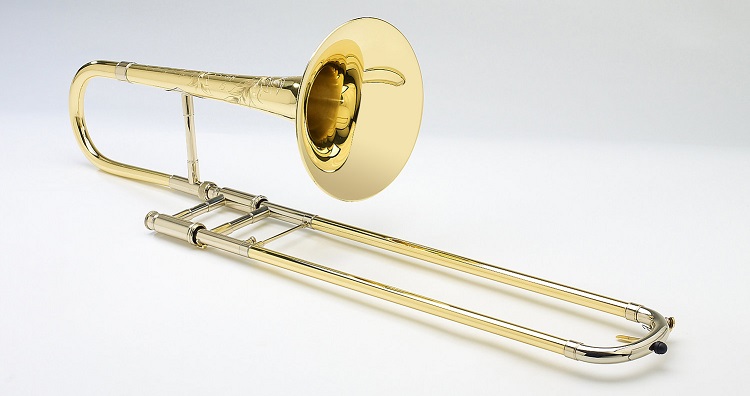
Mozart, Beethoven, Schumann, and many other composers wrote for the Alt-pousane. Alto sackbuts provided countertenor accompaniment to their larger brethren.
The high brilliant sound of the alto trombone was well-known and well-loved by audiences. But as musical education and instrument design improved, most professional tenor trombonists had little difficulty playing parts written for an alto trombone. Because musicians have suffered from poor wages, many saved themselves the cost of a new trombone by making their main instrument play double duty on the high end.
When he was writing Symphonie Fantastique in 1830, Hector Berlioz was forced to insist, “The alto trombone part must not be played on a big trombone, as is often done in France: I demand a true alto trombone.“
But by 1837, when he wrote his Requiem, Berlioz was writing for tenor trombones. For many years alto trombones languished in relative obscurity.
A skilled tenor trombonist can play most alto trombone repertoire, just as a skilled violinist can play most viola’s written works. But just because you can swap one instrument for another doesn’t always mean that you should.
The alto trombone has a ringing sweetness that a tenor trombone lacks and a less forced high range. By the late 20th-century, music directors and audiences realized Berlioz was on to something. And so, in recent years, the alto trombone has seen something of a revival.
Alto vs Tenor Trombone
The alto trombone has shorter tubing and a smaller bell than a tenor trombone. However, the bore size is generally comparable to a small bore tenor. Some alto trombones have a rotary valve that transposes the instrument down into Bb like the tenor trombone.
The alto trombone’s range is from A2 to G5. The pedal and lower notes are not so effective on the alto as on the tenor and lower trombones. Its midrange and high notes are generally considered more melodic.
SE Shires has become famous for the many choices it offers prospective buyers. You can choose between different bores, leadpipes, and materials to ensure you get precisely the instrument you want.
Their Joseph Alessi Q Series Alto Trombone was crafted with input from Joseph Alessi, principal trombonist of the New York Philharmonic. It is a fine trombone that comes in at a very reasonable price: you can pick up an Alessi Q Alto for a bit over $2,500.
Many professional musicians swear by Yamaha instruments for their reliability, quality control, and customer service. Yamaha offers alto trombone players a choice between the YSL-871, a straight alto trombone, and the YSL-872, including a B♭ valve. The 872 offers an alto trombonist more flexibility and an extra fifth on the bottom, while the 871 is more free-blowing.
Contrabass Trombone
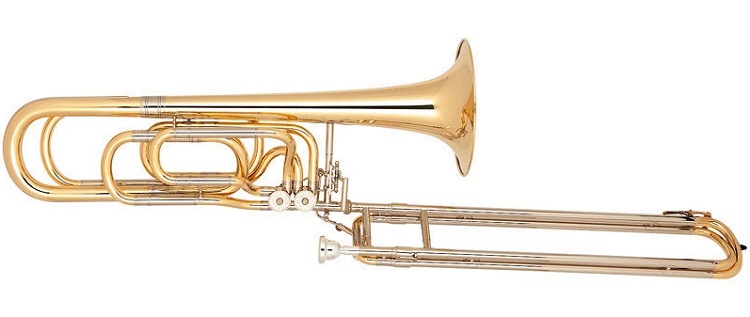
16th-century musicians had a trombone doppio (double trombone) n Italy and an Octav-Pousan in Germany, which played an octave below the tenor sackbut. This contrabass sackbut was only rarely seen, thanks largely to its enormous size. With 18 feet (almost 6 m) of tubing, the trombone doppio could only be played slowly by musicians with very long arms and big lungs. They had to rely on a handle to extend their instrument out to the last positions.
In Berlin, around 1860, C. A. Moritz made a double-slide contrabass trombone in BB♭ for Richard Wagner. The double-slide wrapped twice, making the slide positions less wide and the final positions more manageable. Alas, you still need big lungs to blow air through all that tubing).
Wagner went on to use the contrabass trombone in his Ring cycle. Contrabass trombones were also used by Richard Strauss (Elektra), Giacomo Puccini (La Bohème) and Arnold Schoenberg (Gurrelieder). And the sinister rumble of the contrabass trombone has often been used to great effect in movie and game soundtracks, most notably the final credits of God of War III. any bass trombonists double on contrabass trombone when it is called for in an orchestral arrangement.
The BB♭ contrabass trombone ranges from A♭0 (a step below the lowest piano note) to C5.
One of the most highly regarded contrabass trombones on the market today is the Miraphone BB♭ 670. he 670 has a double slide and a conical bore ranging from 14-15.6 mm (0.55-0.613″), which adds an extra bit of tuba-like oomph to the trombone sound.
A double slide makes the instrument less ungainly, while a rotary valve lets you lower the pitch a perfect fourth to FF. Wagner gave his contrabass trombonist a three-octave workout (E1-E4) in the Ring, and the Miraphone will let you hit every note.
Miraphone, a German brass instrument maker, is famous for its attention to detail. The 670 contrabass – the largest slide trombone on the market – is considered one of their finer achievements.
Soprano Trombone
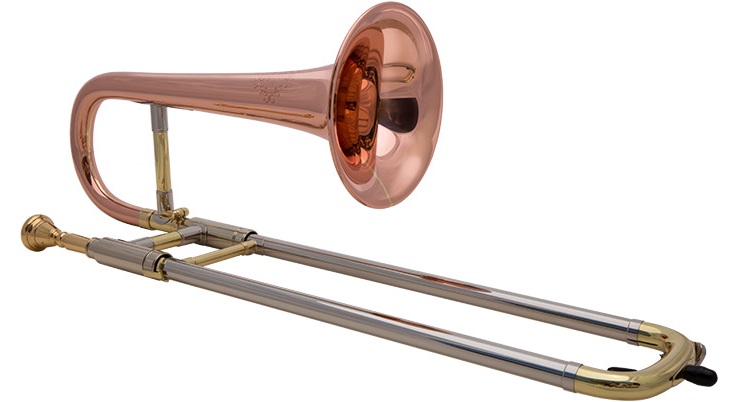
The soprano trombone is pitched one octave above the tenor trombone, in the same range as the trumpet. But because the soprano trumpet is so much smaller.
This makes playing the soprano trombone challenging. With the introduction of valves in the early 19th century, the soprano trombone was one of the first casualties. A trumpeter could play any soprano trombone line faster and more accurately than a trombonist.
The soprano trombone has become more popular in recent years thanks in no small part to Wycliffe Gordon, a tenor trombonist who uses the soprano trombone to play trumpet parts with glissandos you can only achieve with a slide. The soprano trombone is a challenging instrument, but you can get some amazing sounds out of this little beauty with practice.
Soprano trombones survived in the Moravian trombone choirs. Since the 18th century, the Moravian Brethren, a Protestant sect, have used trombones in their religious services.
Their choirs traditionally consisted of soprano, alto, tenor, and bass trombones. Not only did the Moravian Brethren play hymns: they also preserved a great deal of 18th and early 19th-century trombone music, which might otherwise have been lost.
In addition to their cimbasso, Wessex Tubas also offers an inexpensive soprano trombone to help you master the positions and embouchure. Since soprano trombones use trumpet mouthpieces, this will give trombonists some practice should they later decide to go with a regular valve trumpet. Trumpeters interested in a soprano trombone will probably do better picking up an inexpensive tenor trombone and mastering those positions rather than starting with the notoriously fiddly soprano trombone.
They Get Smaller
The smallest trombones available are largely novelty instruments. The sopranino is a fourth above a soprano trombone, and the piccolo plays an entire octave higher. Their tiny slides make them very difficult to play and generally offer only five or six positions instead of the seven required for a full chromatic scale.
The piccolo trombone has a theoretical range of E4-F7 (a bit higher than a flute) and the sopranino from A3-E♭6 (roughly the range of a soprano saxophone). In practice, few players will be able to hit the highest and lowest notes. All players will struggle to make their instrument sound like a trombone rather than a kazoo.
Here’s a performance by the German Brass Ensemble, which will give you an idea of the different trombone sizes and of the trombone’s comic potential.
Bonus Trombone: Superbone
Valves give you extra speed, and slides give you the glissandos that we associate with the trombone sound. The superbone gives you both!
The first combination slide/valve trombone, the valide (for valve + slide), was designed by Brad Gowans, a trombonist who was also a reed player, draftsman, and engineer. Gowans built the first valides himself and later licensed the design to Conn, which produced a few valides between the 1920s and 1950s. But while Gowans continued playing the superbone throughout his career, the instrument never took off.
In the 1970s, trumpet giant Maynard Ferguson had Holton build the TR395, a combination slide/valve trombone he christened the “Superbone.” The TR395 became a showpiece for Maynard Ferguson and big band leader Don Ellis.
But once again, the superbone failed to achieve widespread popularity. While it was certainly versatile, the superbone was difficult to play. The performer had to play the valves left-handed while moving the slide with the right, all the while keeping straight the various valve/slide position combinations. While Holton kept the TR395 in its lineup for a while, the lack of demand made continued construction impractical.
Fortunately, Chinese/British company Wessex Tubas has stepped up to the plate with their own Wessex PB390 superbone. If you want a showpiece musical instrument that gives you all the benefits of a slide and valve trombones (and can deal with the headache of mastering a very complicated instrument), the Wessex PB390 can be had for less than $1,000.
Frequently Asked Questions
Answer: Trombones come in different “home keys.” A tenor trombone’s natural series from the 1st position is a B♭ scale, while the same series on an alto trombone will give you an E♭ scale.
But trombones, like tubas, are a non-transposing instrument. When a tenor trombonist sees a passage in G, they play it in G. When a B♭ clarinetist plays clarinet sheet music written in G; they are actually playing in F.
Answer: As with any brass instrument, playing the trombone requires learning lip embouchure and breath control. But slide trombone also requires learning slide positions and where valves are precise, slides are not.
A bit short and your note will be sharp: a bit long and your note will fall flat. Learning exactly where the slide should be on your instrument takes time and patience. Once you have the basics down, you will need years of steady trombone practice before you begin to unlock the instrument’s full potential.
Question: What is a Moravian Trombone Choir?
Answer: Starting in the early 18th century Moravians, members of a Czech Protestant sect, came to America searching for religious freedom and brought their church music with them. Luther’s German Bible translated shofar as pousane, also the German word for “trombone.” This encouraged the Moravians to use choirs of trombones in SATB (Soprano-Alto-Tenor-Bass) arrangements. Moravian church libraries have also preserved a great deal of trombone music from the 18th and 19th centuries that might otherwise have been lost.
Question: What are Trombone Bore Sizes?
Answer: A trombone’s bore is the diameter of its tubing.
- Small-bore trombones generally have a diameter of .480″ to .510″ (12.2-13 mm). A small-bore trombone has a brighter sound and more delicate feel than a larger bore instrument, but it lacks the power and presence of a larger bore instrument. Small-bore instruments are often used in jazz ensembles.
- Large bore trombones most often have a .547″ (13.9 mm) diameter and are commonly found in orchestral ensembles. A large-bore trombone has a darker, more mellow sound than a small bore instrument and can reach higher volumes but will require more breath from the player.
- Medium bore instruments are slightly larger than small bores but smaller than large bore. (A good example of a medium bore would be the .525″ (13.3 mm) Bach 36, which has the brightness and nimbleness you need when in a first chair position, but with more force than a small bore trombone can muster.
Question: What Key is a Trombone In?
Answer: Soprano, Tenor, and bass trombones are generally in B♭, while alto and piccolino trombones are most frequently in E♭, cimbasso’s in F, and contrabass trombones in either F or B♭. You will frequently find valve tenor trombones in C used in Mexican, Central American, and South American traditional music. You will occasionally find trombones in other keys as well.
While trombones may have different home keys, trombone music is traditionally written in concert pitch. Suppose you are moving from a tenor to an alto trombone. In that case, this means you will have to learn different positions when using your new instrument.
Conclusion: What Trombone is Best for You?
If you are a beginning musician, your best bet is a Tenor Slide Trombone. Tenor trombones are widely available, and there is a great deal of music written for tenor trombonists in every genre and at every performance level. The techniques and slide positions you learn on the tenor trombone will carry over to other trombones.
As a student, you want the best instrument you can afford. The Yamaha YSL-354 is an excellent student instrument that helps you master the trombone technique and holds its value.
If you already own a tenor trombone and are looking for a second instrument, the Bass Trombone may be your best bet. What if you prefer the trombone’s higher register? If you like to play Baroque or 19th Century Romantic music? No problem, the Alto Trombone will give your high notes a beautiful penetrating sound.
If you already play trumpet or another valved instrument, you may want to pick up a Valve Trombone. Once you master the new embouchure and breathing, you’ll have no trouble playing the valve trombone. If you are a serious tubist or trombonist who really wants to expand your musical horizons or like playing low really fast, nothing beats a cimbasso. Either a contrabass trombone or a cimbasso will be a big investment. Still, a cimbasso will be easier on your lungs and be able to handle passages that would be outside a contrabass trombone’s capability.
Looking for more interesting readings check out:

